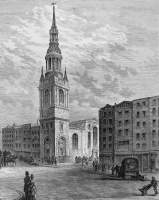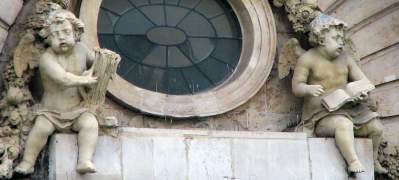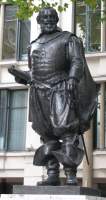 View of St Mary le Bow, 1890s.
View of St Mary le Bow, 1890s.
 View of St Mary le Bow, 1890s.
View of St Mary le Bow, 1890s.
St Mary Le Bow on Cheapside features on these pages for its sculptural interest, which is relatively minor compared to the greater importance of its architecture, so we will start with that.
The church is by Wren and dates from the 1670s. It has a particularly fine steeple, which was often repaired and rebuilt, most notably in 1820 by G. Gwilt. Like many London churches, there were previous churches on the site; the pre-Fire church was itself built on the ruins of one from the time of William the Conqueror, and, and the name of ‘Bow Bells’ associated with the church is thought to arise from stone arches (‘bows’) of the Norman crypt underneath the present building. That building itself stood on the site of a Roman temple, and Wren found a Roman pavement when digging his foundations. The form of the Wren church, presumably in acknowledgement of these origins, apparently was taken from that of the Temple of Peace at Rome. The whole church and tower were severely damaged by bombing in World War 2, and restoration took place through until the 1960s.
Now to the sculpture. Atop the spire is a weather vane in the form of a dragon, which I believe to be original, and certainly of interest to these pages – the 17th Century sculptor Edward Pearce carved the original wooden model for it, with the copper version emplaced in 1679, described after it was taken down during the 1820 restoration of the steeple: ‘The figure is of copper, nearly nine feet long; it works upon an Egyptian pebble; the spindle is of polished steel, and the whole is in good taste, and of superior workmanship.’ It can be discerned if you click on the engraving at the top of this page to enlarge it.
 Cherubic decoration, perhaps by Thomas Cartwright the Elder.
Cherubic decoration, perhaps by Thomas Cartwright the Elder.
The stone tower has pairs of cherubs over each entrance, with festoons of fruit and leaves, and a variety of winged cherubic heads, as well as fronds of carved foliage in the spandrels below. The heavy-jowled cherubs look right for the 17th century, but who made them? Thomas Cartwright the Elder (c15617-1702), assisted by the somewhat obscure John Thompson, is noted by Gunnis as having worked on the steeple, but the cherubs are not specifically mentioned: Cartwright did other work for City churches in this vein.
Inside, the church has the clean look of meticulous post-War restoration, with modern stained glass of considerable merit. The church is the Australian church in London, and there is a bust of Admiral Arthur Phillip (d.1814), first Governor of Australia, a good modern work by the sculptor C. L. Hartwell, known for portrait busts and some good war memorials (including the St George and the Dragon at St John’s Wood by Lords cricket ground), mostly from the 1920s-30s. (An identical bust with accompanying plaques close to St Pauls is shown on this page.)
Information in the church notes among other art a Rood given by West Germany in 1964, and a bronze relief of St George and the Dragon by Ragnhild Buttenschon, given by the King and People of Norway in part to commemorate the Norwegian resistance.
Notable monuments lost in the bombing include one by Peter Scheemakers to Mathew Howard (1737), a bust to the head of the Cart family by Samuel Tuffnell, and a monument to Humphrey Levins (1681) by the much less well-known Thomas Davies. A bust of Bishop Newton of Bristol (d1782), author of a work on the Prophesies, 30 years rector in the parish, by Thomas Banks, the eminent Royal Academician, apparently was damaged but survived and remains in the possession of the church.
Outside in the little churchyard is a bronze statue of John Smith, a replica by Charles Remick of a 1907 work by William Couper. Smith, the plinth records, was a leader of the founders of the colony of Virginia, USA, and this statue was presented by the Jamestown Foundation of the Commonwealth of Virginia. A good civic statue, with the subject dressed in appropriately flamboyant fashion. He was buried in St Sepulchre Holborn. It is particularly welcome to have representative work by the American sculptor Couper in England: he was born in America in 1853, trained in Europe and lived for two decades in Italy, and then settled in New York in 1897. His main work consisted of portraits, busts and bas reliefs, with at least a few ideal works early in his career.
There are various explorable passages around this church, with some decoration, for example 6-8 Bow Lane has plaster heads and interesting iron pillars.
 John Smith, first Governor of the Colony of Virginia, USA.
John Smith, first Governor of the Colony of Virginia, USA.
East then South down Walbrook to St Stephen Walbrook // East then down King William St to St Mary Woolnoth // North to St Alban's Wood Street
City Churches // Christopher Wren // London sculpture // Sculptors // Introduction to church monuments
Angel statues // Cherub sculpture
Visits to this page from 4 Jan 2012: 12,001